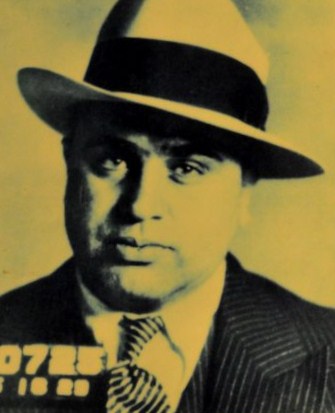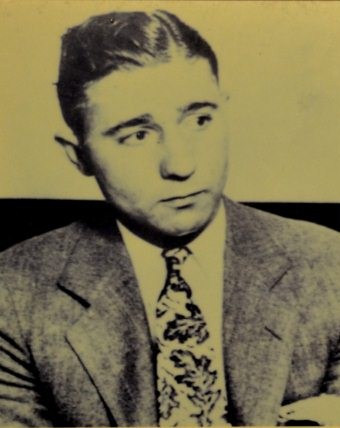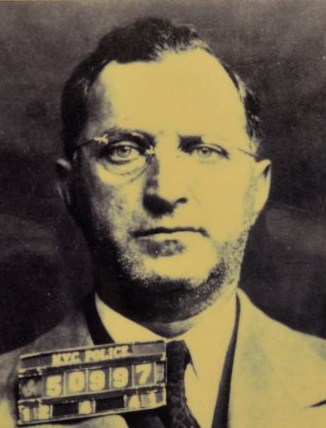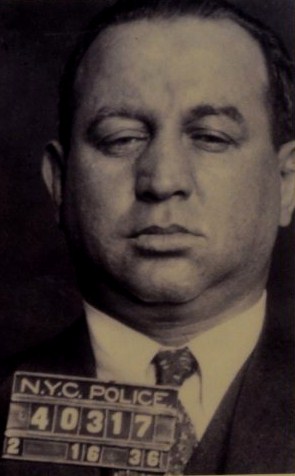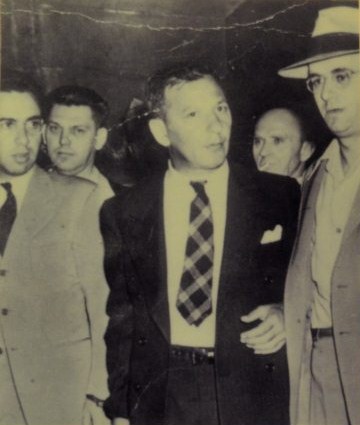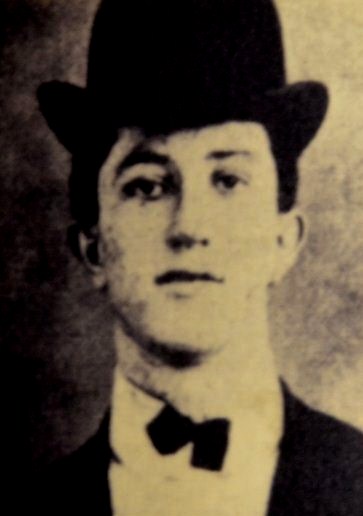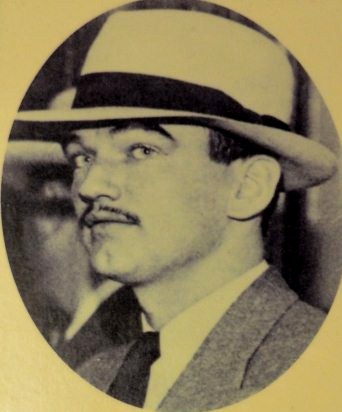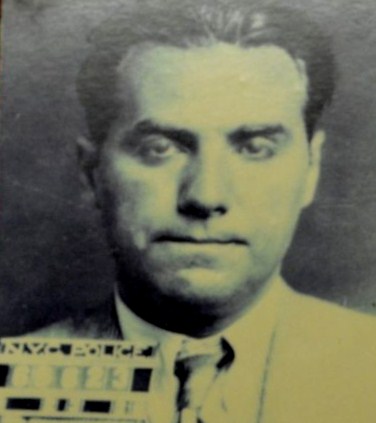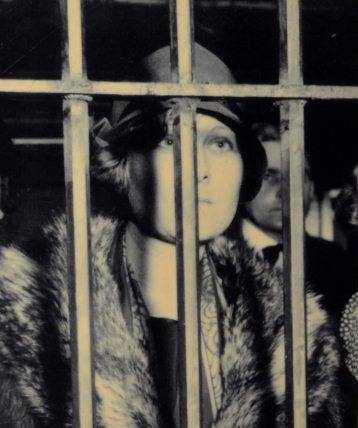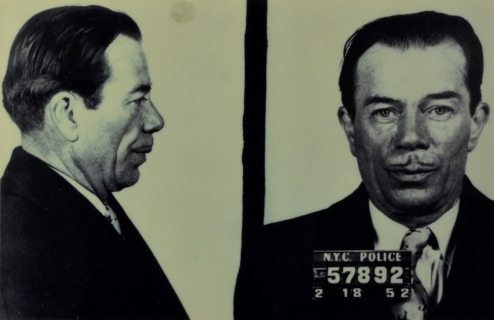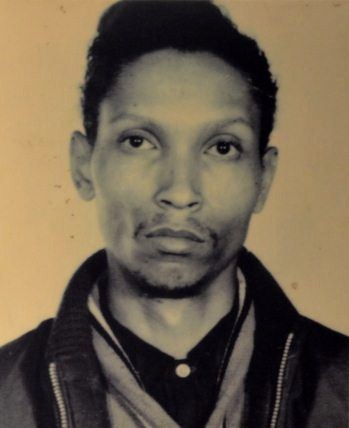Museum Baddies

|
Baddies - Notorious Criminals
- the NYPD featured at the Museum
Notorious Criminals. For people who live in New York, crime is often something taken for
granted. Unlike small town America where a murder, even a mugging, can grab
headlines, New York tends to ignore the details of much of the crime. But every
so often a criminal comes along whose actions shock even the most jaded New
Yorker. They commit crimes so heinous or so outlandish that they are impossible
to ignore. As the individual cases profiled next indicate, not all of the
centuries’ most memorable crimes were murder. Some also involved theft,
terrorism and kidnapping. In every case the NYPD was at the centre of the story,
from the initial investigation to the eventual arrest, trial and conviction of
the perpetrator.
 Gangsters: Benjamin "Dopey Benny" Fein (1889 - 1962) was an early Jewish American gangster who dominated New York labor racketeering in the 1910’s. With a criminal record dating back to 1900, Fein's arrest record included thirty charges from petty theft and assault to grand larceny and murder (of which he was acquitted twice due to lack of evidence). Fein was nicknamed "Dopey Benny" because of his eyes always being halfway-closed due to a medical condition. Fein was spared a mandatory life sentence for fourth time offenders and instead received a reduced sentence of ten to twenty years disappearing from public records sometime after.
Born to immigrant parents in Brooklyn, 1899, Al Capone grew up influenced by local mobsters Johnny Torrio and Frankie Yale. In 1921 he joined Torrio in Chicago and soon became his partner in running an enormous underworld operation involving bootlegging, prostitution, gambling, extortion and loan sharking. He moved quickly to eliminate his competitors, including his old mentor back in New York, Frankie Yale in July 1928. The gang wars culminated in the St Valentine’s Day massacre of 1929, which placed him at the top of Chicago’s underworld. He was convicted of tax evasion in 1931. In May 1932, Capone was sent to Atlanta U.S. Penitentiary, but he was able to obtain special privileges. Later, for a short period of time, he was transferred to the Lincoln Heights Jail. He was transferred to Alcatraz on the 11th of August 1934, which was newly established as a prison on an island off San Francisco. The warden kept tight security and cut off Capone's contact with colleagues. His isolation and the repeal of Prohibition in December 1933, which reduced a major source of revenue, diminished his power. Capone had some problems at Alcatraz. While working in the prison basement, he got into an argument with an inmate who was standing in line waiting for a haircut; this person then stabbed him with a pair of shears. Capone was admitted into the prison hospital with a minor wound and released a few days later. In addition, his health declined as the syphilis which he had contracted as a youth progressed. He spent the last year of his sentence in the prison hospital, confused and disoriented. Capone completed his term in Alcatraz on the 6th of January, 1939, and was transferred to the Federal Correctional Institution at Terminal Island in California, to serve his one-year misdemeanor sentence. He was paroled on the 16th of November 1939, and, after having spent a short time in a hospital, returned to his home in Palm Island, Florida. Later years: Capone's control and interests within organized crime diminished rapidly after his imprisonment, and he was no longer able to run the Outfit after his release. He had lost weight, and his physical and mental health had deteriorated under the effects of neurosyphilis. He had become incapable of resuming his gang activity. In 1946, his physician and a Baltimore psychiatrist performed examinations and concluded that Capone then had the mental capability of a 12-year-old child. He often raved about Communists, foreigners and George Moran, whom he was convinced was plotting to kill him from his Ohio prison cell. On the 21st of January 1947, Capone had a stroke. He regained consciousness and started to improve but contracted pneumonia on the 24th of January. He suffered a fatal cardiac arrest the next day. He died in his home in Miami Beach, Florida, surrounded by his family.
Frankie Yale. Born Francesco Loele in Calabria, Italy (he later Americanised his name), he grew up to be one of Brooklyn’s most feared gangsters. In 1917 he bought a bar in Coney Island and hired an eighteen year old Al Capone as a bartender. It was the beginning of a long relationship and by the mid 1920’s Yale was helping Capone move illegal alcohol from New York to the Midwest. But when Capone learned that Yale was pocketing some of his profits from the operation, he ordered him eliminated. After a number of near misses, Capone’s men, including Albert Ansalmi and Jack Scalise, finally got Yale while driving in Brooklyn. His funeral was one of the biggest the city had ever seen.
Vincenzo Gibaldi or Vincent Demora, also known as Machine Gun Jack McGurn, Gibaldi was born in Licata, Sicily but grew up in Brooklyn with his parents. At the age of fifteen he moved to Chicago where he eventually worked for Al Capone. He masterminded the 1929 St. Valentine’s Day massacre that wiped out seven of Al Capone’s mobster rivals.
In 1917, a New York hood by the name of Frank Galluccio entered the dance hall/ speakeasy with his sister Lena and his date by the name of Maria Tanzio. AL Capone was an eighteen year old bartender at the Harvard Inn at Coney Island. Al noticed Galluccio's young sister and began smiling at her. Lena became annoyed and embarrassed at Capone's constant staring and advances that she asked her brother Frank to kindly ask Capone to stop it. Frank was just about to ask Capone to stop when Capone leans over to Lena and tells her "Honey, you got a nice butt and i mean that as a compliment, believe me" Frank hears this and goes ballistic, he quickly tells Capone that he won't thake this from anybody and he demands that Capone apologize immediately to his sister or else Al tells Frank "Come on buddy. I'm only joking" Galluccio responds "This is no effin joke" Capone at that moment stops smiling and charges at Galluccio who quickly takes out a razor and slashes Capone three times. He aimed for the neck, but got his face instead as Galluccio had several drinks that night. Capone needed up to 30 stitches. The wounds would give him the nickname “Scarface”, an appellation he detested. Years later when Capone entered organised crime he forgave Galluccio and hired him as his bodyguard.
Jacob "Gurrah" Shapiro was Louis “Lepke” Buchalter’s lifetime ally in the infamous Garment Centre Rackets. Shapiro and Buchalter (below) soon formed the infamous Murder, Inc., an organisation that performed contract murders for organised crime. Their client was the "National Crime Syndicate", a confederation of crime families created by Luciano and Lansky in 1929. The Syndicate was created to avoid the bloody gang wars of the 1920's by creating an organization with the power to mediate organized crime disputes and punish offenders. Murder, Inc. served as the enforcement arm for the Syndicate. With Buchalter leading Murder, Inc., Shapiro and Albert "Mad Hatter" Anastasia were his most trusted associates. One of its most dedicated members, Shapiro personally oversaw many contract murders and recruited promising gunmen for future membership. During the early 1930’s, US Attorney Thomas E. Dewey started to prosecute organised crime members in New York City. The pressure created by Dewey was such that in 1935 mobster Dutch Schultz asked the National Crime Syndicate to approve Dewey's murder. Shapiro and Anastasia agreed with Schultz, but Buchalter and the rest of the Syndicate turned down his request. Killing a prosecutor went against mob tradition, the majority argued, and would only increase federal investigation into organised crime and possibly expose the Syndicate itself. In fact, the Syndicate was so fearful of Schultz's proposal that they later ordered Buchalter to murder Schultz. On the 23rd of October 1935, Schultz and several associates were gunned down by Murder, Inc. gunmen in a restaurant in Newark, New Jersey. Shortly after Schultz's death, Shapiro and Buchalter became the focus of Dewey's investigations. In October, 1936, Shapiro and Buchalter were convicted under the terms of the Sherman Anti-Trust Act and were both sentenced to two years in Sing Sing Prison. After his conviction, Shapiro went into hiding for a year. However, he finally turned himself in to FBI agents on the 14th of April 1938 and was sent to prison. On the 5th of May 1944, Shapiro was convicted of conspiracy and extortion and sentenced to thirty years to life in prison. Months before his 1944 conviction, Shapiro allegedly smuggled a note to Buchalter, who was then on trial in New York for murder. The note simply read, "I told you so." On the 4th of March 1944, Buchalter was electrocuted in Sing Sing Prison in Ossining, New York. Until his death in prison from a heart attack in 1947, Shapiro remained convinced that had Dewey been killed, he and others would have remained free.
Born in 1897 Louis “Lepke” Buchalter grew up on the Lower East Side of Manhattan. He was extremely successful in a wide range of crimes, but specialised in extortion and racketeering within the garment industry. In 1937 he became the target of District Attorney (and future presidential candidate) Thomas Dewey and went into hiding. Two years later, hoping to evade state charges for murder, he turned himself in to the FBI (the feds only wanted him for fleeing arrest and anti-trust violations). He received a thirty year sentence instead and was turned over to state authorities who immediately tried him for murder. In 1944, Buchalter became the only major organised crime figure in America to go to the electric chair.
Abe "Kid Twist" Reles, born on the 10th of May 1906, was a New York mobster who was widely considered the most feared hit man for Murder, Inc., the enforcement contractor for the National Crime Syndicate. Reles later turned government witness and sent several members of Murder, Inc. to the electric chair. In the early morning of the 12th of November 1941, Abe Reles fell to his death from a hotel window. It is not known whether he was thrown or pushed out the window, or if he was trying to escape. The angle of trajectory suggests that he was in fact pushed. Because of his mob status as a "stool pigeon" and the circumstances surrounding his death, Reles gained another moniker after his passing. Reles became known in a newspaper article, as "the canary who sang, but couldn't fly." Reles is buried in Old Mount Carmel Cemetery in the Glendale section of Queens, New York.
Vincent “Mad Dog” Coll had one of the shortest and most violent careers of any notorious gangster. After a troubled youth in Throgs Neck, Coll began working as an enforcer for the bootlegging kingpin, Dutch Schultz. He harboured illusions of grandeur and when he was just twenty two he staged a gangland revolt to unseat Schultz and take over his operations. Dozens of gangsters died in the resulting war. One of these incidents, a drive-by shooting that accidently killed a five year old boy, earning him the name ”babykiller”. Six months later, with Schultz offering $50,000 price for his demise, his brief career came to a predictably violent end when he was gunned down in a drugstore phone booth.
One of the most proficient executioners was Harry Strauss who killed at least thirty men in a dozen cities. Harry "Pittsburgh Phil" Strauss born on the 28th of July 1909 was a prolific contract killer for Murder, Inc. in the 1930’s, a Brooklyn based company responsible for the killing of around a thousand people coast to coast from the 1920’s to the early 40’s. Harry killed over thirty men using a variety of methods; shooting, stabbing with ice picks, drowning, live burial and strangling rope. Strauss never carried a weapon unless he was about to make a hit. “It’s OK to do murder, as long as you don’t get caught.” He worked for the likes of Lucky Luciano, Albert Anastasia and Bugsy Siegel. Most of his associates called him "Pep". In the 1930’s, he was committing assaults, larcenies and drug dealing. He was arrested 18 times but was never convicted until he was found guilty of the homicide that sent him and fellow Murder Inc. hitman Martin "Buggsy" Goldstein to the electric chair. After hit man Abe "Kid Twist" Reles turned informant, Strauss was arrested for the murder of Irving Feinstein, and at least five other known murders. Strauss tried to avoid conviction by feigning insanity in the courtroom and on death row. He was executed in the electric chair at Sing Sing on the 12th of June 1941.
Arnold Rothstein was known as both the “Czar of the Underworld”, and the “Broadway Playboy and Gambler” who had a wide range of associates, including bootleggers, narcotics dealers, labour leaders and real estate developers. On the 4th of November 1928, Arnold Rothstein was shot and mortally wounded while conducting some business affairs at Manhattan's Park Central Hotel. He died the next day at the Stuyvesant Polyclinic Hospital in Manhattan The shooting was allegedly linked to a gambling event that Rothstein had participated in the previous month with several associates and acquaintances. According to underworld folklore, it was a spectacular three-day, high-stakes poker game held somewhere in Manhattan. Rothstein apparently experienced a cold streak with the cards and ended up owing $320,000 at the end of the game. However, Rothstein refused to pay the debt, claiming the game was fixed. The hit was arranged to punish Rothstein for reneging on this debt. Gambler George "Hump" McManus was arrested for the murder, but later acquitted for lack of evidence. Rothstein, on his deathbed, refused to identify his killer, answering police inquiries with "You stick to your trade. I'll stick to mine" and "Me mudder did it". Rothstein was buried at Ridgewood's Union Field Cemetery in a Jewish Orthodox ceremony.
Others: When the NYPD first arrived at her home, Ruth Snyder seemed the victim of a horrible act of random violence. They found her in the hallway, bound and gagged. Her husband, Arthur, lay dead from strangulation nearby. Brown claimed an intruder “apparently a foreigner”, had broken in, assaulted them and stolen their valuables. Detectives soon had doubts; they found Snyder’s jewellery under her bed and there was no sign of forced entry. Investigations revealed that she had a boyfriend, Judd Gray. When confronted he quickly confessed and spilled the details of their plot to kill Arthur. After a sensational trial the two were sentenced to death and Ruth Snyder became the first woman to die in the electric chair on the 12th of January 1928.
Bruno Richard Hauptmann. Americans were stunned in March 1932 to learn that the baby of Charles Lindberg, the famous aviator, was kidnapped from their home in New Jersey. Lindberg paid the $5,000 in ransom, but the baby was later found dead. The case remained unsolved for two and a half years. In September 1934 a carpenter named Richard Hauptmann aroused the suspicion of a Manhattan gas station attendant when he paid with a $10.00 gold certificate. The attendant copied down Hauptmann’s license number plate and called the police. When the serial number on the bill matched the one’s paid by Lindberg, NYPD detectives arrested Hauptmann. At his home in the Bronx they discovered a cache of almost $14,000 more Lindberg money. The trial was sensational that made the headlines worldwide. Despite Governor Hoffman's evident doubt as to Hauptmann's guilt, Hoffman was unable to convince the Court of Errors to re-examine the case, and on the 3rd of April 1936, Hauptmann was executed in Old Smokey, the electric chair at New Jersey State Prison. Hauptmann had requested a last meal consisting of celery, olives, chicken, French fries, buttered peas, cherries and cake. Reporters present at the execution reported that he went to the electric chair without saying any last words, but other reports later said that he was vehemently protesting his innocence.
George P. “Mad Bomber” Metesky was a law-abiding citizen until an on-the-job injury forced him to
retire from Con Edison in 1934. Denied workman’s compensation, he took out his
anger on the entire city. Between 1940 and 1956 the Mad Bomber, planted thirty
three bombs in public places such as Grand Central Station. No one was killed in
the resulting twenty three explosions, but fifteen people suffered injury. NYPD
detectives eventually discovered his Con Edison connection and combed through
thousands of personnel files until they found him. Metesky was arrested in 1957,
convicted and sentenced to 17 years in an asylum for the criminally insane.
In 1973, the United
States Supreme Court ruled that a mentally
ill defendant cannot be committed to a hospital operated by the New
York State Department of Correctional Services unless a jury finds
him dangerous. Since Metesky had been committed to Matteawan without a jury
trial, he was transferred to the Creedmoor
Psychiatric Center, a state hospital outside the correctional system.
Doctors determined that he was harmless, and because he had already served
two-thirds of the 25-year maximum sentence he would have received at trial,
Metesky was released on the 13th of December 1973. The single condition was that
he make regular visits to a Connecticut Department of Mental Hygiene clinic near
his home. Interviewed by a reporter upon his release, he said that he had
forsworn violence, but reaffirmed his anger and resentment toward Consolidated
Edison. He also stated that before he began planting his bombs.
Metesky returned to his home in Waterbury, where he died 20 years later at the age of 90.
Willie Sutton grew up in Brooklyn and had a lengthy police record by the time he was
in his early teens. From the 1920’s to the 1950’s Sutton was the nation’s most
infamous bank robber, stealing over $2 million over the course of his “career”.
He also displayed a talent for escaping from jail three times. He is best
remembered for his answer to why he robbed banks. “Because that’s where the
money is.” His last heist took place in Queens in 1950 and landed him in prison
for seventeen years. Once a free man, he spoke about prison
reform and consulted with banks on anti-robbery techniques. In an
ironic display, he made a television commercial for New Britain Bank and Trust
Co. in Connecticut for their credit card with picture ID on it. His lines were,
"They call it the 'face card.' Now when I say I'm Willie Sutton, people believe
me." Sutton died in 1980 at the age of 79; before this he had spent his last
years with his sister in Spring
Hill, Florida. He frequented the Spring Hill Restaurant where he kept
to himself. After Sutton's death, his family arranged a quiet burial in Brooklyn
in the family plot. Sutton's Law states that when diagnosing, one should first consider the obvious. It suggests that one should first conduct those tests which could confirm (or rule out) the most likely diagnosis. It is taught in medical schools to suggest to medical students that they might best order tests in that sequence which is most likely to result in an accurate diagnosis, hence treatment, while minimizing unnecessary costs. It is applicable to any process of diagnosis, e.g. debugging computer programs. Computer-aided diagnosis provides a statistical and quantitative approach.
One of the 1960’s most sensational crimes was the brutal murder of Kitty
Genovese. She was attacked and stabbed to death by Winston Moseley in Kew Gardens, Queens. The most
shocking aspect of the murder was the revelation that the police interviewed
thirty eight people who heard Genovese scream for help, but failed to call the
police or go to her aid. For months afterwards, New Yorkers wrestled with the
question of whether modern city life had made them apathetic individualists.
Numerous examinations of public apathy were published in the following years.
Moseley also testified at his own trial where he further described the attack
(along with two other murders and numerous attacks), leaving no question that he
was the killer. He was convicted of murder. On Monday the 15th of June 1964,
when the death
sentence was announced by the jury foreman "The courtroom erupted
into loud spontaneous applause and cheers." When calm had returned, the judge
added, "I don't believe in capital punishment, but when I see this monster, I
wouldn't hesitate to pull the switch myself!" On the 1st of June 1967, the New
York Court of Appeals found that Moseley should have been able to
argue that he was "medically insane" at the sentencing hearing when the trial
court found that he had been legally sane, and the initial death sentence was
reduced to an indeterminate sentence/lifetime imprisonment. In 1968, during a
trip to a Buffalo,
New
York hospital for surgery, Moseley overpowered a guard and beat him
up to the point that his eyes were bloody. He then took a bat and swung it at
the closest person to him and took five hostages, raping one of them in front of
her husband - actions he later blamed his parents for - before he was recaptured
after a two-day manhunt. He also participated in the 1971 Attica
Prison riots. In the late 1970's Moseley obtained a B.A. in Sociology
in prison. Moseley's first parole hearing in 1984 included his defense that "For
a victim outside, it's a one-time or one-hour or one-minute affair, but for the
person who's caught, it's forever." Moseley remains in prison after being denied
parole a thirteenth time on the 11th of March 2008. Moseley's next parole
hearing is scheduled for November 2011. ALL IN ALL DEADLY BUT FASCINATING |
